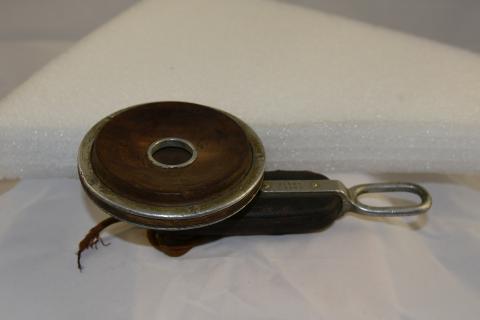This is an earpiece of a German field telephone. This piece would originally have been connected to a microphone receiver and resembled a very early form of the more modern dial telephone. The earpiece itself is made of a metal casing with a wood or cork interior lining. The casing is attached to a handle of wood or cork wrapped in a thin layer of black leather. The bottom of the upper portion of the wrapped handle is attached to an ovular metal loop via a set of flathead screws. A pair of frayed wires runs out of the upper portion of the earpiece and are covered in an insulating wrapping of cloth. The serial number 248846 is engraved on the metal loop. Field telephones were a relatively new invention in the late 1800s. They saw their first extensive use by combat units during the Russo-Japanese War (1904 - 1905), where artillery units would use them to coordinate strikes with infantry regiments. During the First World War, every major power used field telephones extensively, as they could often be the fastest method of relaying information from command headquarters to the front lines. The weakness of field telephones was that the wires were vulnerable to artillery barrages or cutting by enemy soldiers. Effective use of field telephones and telegraph lines enabled the German Army to continually thwart Russian forces invading eastern Germany during the first months of the war. This content can be used with the following resources: SS.4.25: Technological Change This content can be used to educate students on the ways in which telecommunications technology advanced during the early twentieth century as a result of the First World War's impact. Field telephones were the military precursors to the modern telephones that we use today, thus making them an important part of the history of communications technology around the world. For any use other than instructional resources, please check with the organization that owns this item for any copyright restrictions.
2018.002.011 [Telephone]
Legal Status
Copyright to this resource is held by the Iowa Masonic Library and Museum and has been provided here for educational purposes only, specifically for use in the Iowa Museum Association's "Teaching Iowa History" project. It may not be downloaded, reproduced or distributed in any format without written permission from the Rights Holder. For more information on U.S. and International copyright laws, consult an attorney.

